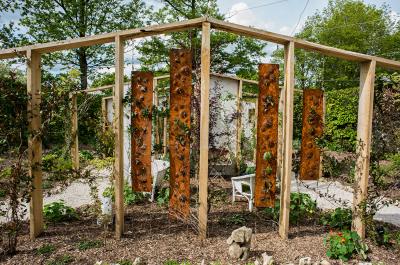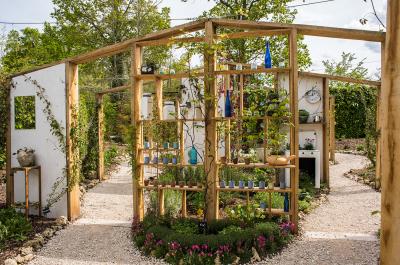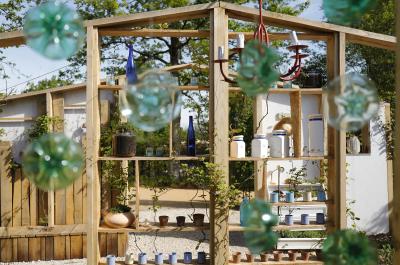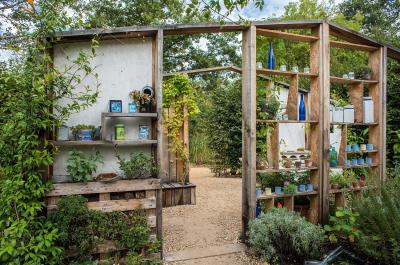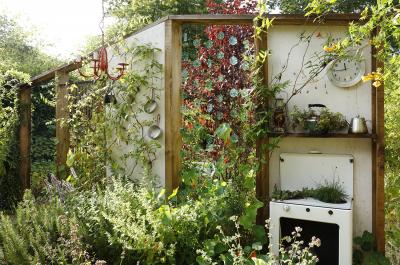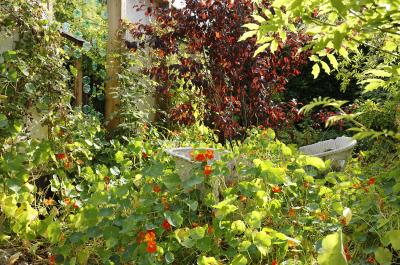03. Oikos
Cities are home to four billion people: this overcrowding is a threat to nature in our largest cities and the intensive use of natural resources is placing our planet in jeopardy. Initiatives that once again embrace nature in our everyday lives and develop new lifestyles are cropping up to counter this new threat in the history of our society.
Vertical vegetable plots, hydroponic farms, roof spaces making use of permaculture or the pooling of compost containers are just some examples of the initiatives that are gradually taking hold through networks to pave the way to material recycling, citizen-based cooperation and community ties in the future. The world of tomorrow taking shape is breaking free from the limits separating the city from nature, striving instead for "ecosophy" as defined by Guattari (1989): a mental, social and environmental wisdom to inhabit it. By inhabiting first, each individual will then go on to fashion the garden of tomorrow.
DESIGNERS
FRANCE

From left to right: Mathilde Gallichet, Anna-Laura Bourguignon, Mathieu Locret, Stéphane Avenet and Manon Damiens
Anna-Laura Bourguignon, a composite first name revealing her Mexican roots, was born in France, grew up in Guadalajara and then in Belgium, and spent her teenage years in Boulogne. She then took up architecture studies in Paris and Mexico. Needless to say, she is well-travelled! She began experimenting as a landscaper with local Mexican plants when just four years of age, trying to grow a garden on her mum's kitchen tiles. At ten her taste buds prompted her to look more closely at spice cultivation, a hobby that would grow and drive her professionally. At 14, a quiet spell ensued when her imagination took a backseat to enable her to succeed academically, and she preferred to swap plants for concrete, because flowers are perishable, but concrete is long-lasting. At 18 she began a career in architecture at the Val-de-Seine National School of Architecture. She could have completed the course within the allotted five years, but the exchange year she took at the Mexico University of Architecture (UNAM) gave her back a taste for Mexican flavours and she returned to botany and to cookery. She remained an "addict" for two years, before returning to Paris to shut herself off and complete her studies, and finally embark on the garden of tomorrow.
Stéphane Avenet
"I have been drawn to Nature ever since I was a child – plants in particular – and over time my conviction that actively protecting the environment is a duty has become deeply ingrained. But it was the belief that only hands-on action carries any meaning which prompted me to become a professional gardener and, in 2004, I founded my landscaping business Coccinelles & Jardins. Firmly committed to practising this profession in an ecological way, I soon found partners to enable me to move in this direction. Wood used in all its forms has always featured prominently in my job as a landscaper. I am always on the look-out for new knowledge and alternative techniques and, in turn, I like to pass this onto others by training several people in my company every year, and by teaching in training centres at regular intervals."
Mathilde Gallichet is a State-qualified architect. She graduated from the Paris-Val-de-Seine National School of Architecture after a foundation year in applied art and six years spent walking the streets of Paris and breathing its air choked with particles which have nothing natural about them. Longing for some fresher air and new horizons, she bid farewell to the City of Lights where she had matured and set off in search of alternatives and undertakings. This decision took her to Central America where she spent four months in the village of Zacatecoluca in El Salvador. Planning an old coffee farm’s (finca) conversion into a social innovation laboratory aimed at passing eco-agricultural knowledge down to the next generations, soaking up new cultures more geared towards solidarity and above all contemplating the unbelievable wealth and fragile existence of the plant world.
Mathieu Locret is a landscape gardener. He is never happier than when sinking his hands deep into the soil. The reasons he gives are as follows: "I have loved colours and shapes for as long as I can remember." Unable to settle decisively for painting or sculpture, and with a deep respect for nature, he became a landscape gardener. These days he comes up with designs and puts these into practice for households. He develops utilitarian and ornamental gardens, and the range of edible plants is worked along the lines of abundant plant profusion. "Designing happy spaces is my sole aim in my daily garden.”
After graduating in the Art Professions from the National School for Applied Arts and Art Professions (ENSAAMA) in 2003, metal sculptor Manon Damiens went on to work in theatre and cinema as a set designer alongside Guy Claude François and Laurence Bruley. Ever eager to learn more, she is widely travelled, living in the Niger for two years where she learned how to make Tuareg jewellery from the master blacksmith Ousmane Anour. Returning to France, armed with all these experiences and aware that she had gained her independence as an artist, Manon felt ready to go it alone, and opened her own metal sculpture studio in Narbonne... She quickly landed her first exhibition followed by support from the Regional Cultural Affairs Directorate (DRAC), a municipality in the Aude invited her to do an artist's residency, commissions flooded in, galleries jumped at regular opportunities for exhibitions of her work and she joined the Ateliers d'art de France... Metal has always appealed to her: she knocks, welds, cuts, dreams up forms and movement in this metal which can look clunky and cold at first sight. Her obsession: bringing out the lightness of the matter... By infusing the metal with her sensitivity, Manon designs spaces, gaps, cracks, empty space for the lighter-than-air metal to breathe, undulate and to live in step with the ever-changing atmosphere... Her work involves making the metal feathery-light, mobile, supple and sometimes even musical... In her quest Manon strives to inspire our imaginations, as onlookers, with freedom and poetry, and to awaken our childhood dreams. A caress, a breath, a light touch and the work quivers as we pass by, and it isn't rare to see visitors tapping their feet on the ground or blowing gently on the works and smiling as these latter react by swaying or tinkling back. Intangible and sensitive vibrations that are nonetheless bursting with life and which conjure up very real interaction between the artist and the audience, who have become actors...

